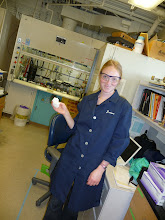Ever wonder why we're here? How life started in the first place?
I hope so!
The mechanism by which chaos was long ago transformed into ordered, living creatures has, and will continue to remain quite elusive. Nevertheless, it remains an active area of research, with varied approaches to understanding the origin of life. The vast importance of chemistry in this pursuit is evident in the historical evolution of inquiry.
In 1989, Thomas Cech at the University of Colorado, Boulder, was awarded the Nobel Prize in chemistry for his discovery that Ribonucleic acid (RNA) in the single-celled Tetrahymena thermophila could cleave and subsequently reconnect itself in the absence of a protein enzyme (i.e., RNA, which stores genetic information in the form of nucleotides, could act as a "ribozyme" and do its own chemistry!). This finding not only undermined popular beliefs surrounding the "central dogma" of molecular biology, which postulated that genetic information is transferred only from DNA to RNA to protein and not in the opposite direction, but it also shed light on an ongoing quest to determine what came first: DNA/RNA or protein (information or function)? Several cases of RNA acting in a "biocatalytic" fashion--both inter- and intramolecularly--were discovered soon thereafter, which lent further credence to an interesting possibility: the first organism capable of reproducing itself may have contained only RNA.
But how could RNA, a complex macromolecule, spontaneously form from the disorganized soup of materials (a mixture of variable gases, heat and light) that were likely available on the prebiotic Earth?
Stanley Miller and Harold Urey showed in 1953 that amino acids could be formed under conditions that were thought to simulate the prebiotic Earth (a mixture of gases and electric current in a closed system). Under similar conditions, Juan Oró later synthesized both amino acids and nucleotide bases (constituents of DNA and RNA). These results were ground-breaking (albeit within the contexts of gross suppositions about the conditions of the Earth and the influence of the surrounding solar system when life started) and they paved the way for further study in the area. In particular, they illustrated the important role of chemistry in elucidating the transformation from simple to complex.
Now the task remains to synthesize a living, RNA-containing organism in the lab. But even this won't answer the million-dollar question of how life began. Billions of years of growth and change have forever erased the prospect of knowing.
I hope so!
The mechanism by which chaos was long ago transformed into ordered, living creatures has, and will continue to remain quite elusive. Nevertheless, it remains an active area of research, with varied approaches to understanding the origin of life. The vast importance of chemistry in this pursuit is evident in the historical evolution of inquiry.
In 1989, Thomas Cech at the University of Colorado, Boulder, was awarded the Nobel Prize in chemistry for his discovery that Ribonucleic acid (RNA) in the single-celled Tetrahymena thermophila could cleave and subsequently reconnect itself in the absence of a protein enzyme (i.e., RNA, which stores genetic information in the form of nucleotides, could act as a "ribozyme" and do its own chemistry!). This finding not only undermined popular beliefs surrounding the "central dogma" of molecular biology, which postulated that genetic information is transferred only from DNA to RNA to protein and not in the opposite direction, but it also shed light on an ongoing quest to determine what came first: DNA/RNA or protein (information or function)? Several cases of RNA acting in a "biocatalytic" fashion--both inter- and intramolecularly--were discovered soon thereafter, which lent further credence to an interesting possibility: the first organism capable of reproducing itself may have contained only RNA.
But how could RNA, a complex macromolecule, spontaneously form from the disorganized soup of materials (a mixture of variable gases, heat and light) that were likely available on the prebiotic Earth?
Stanley Miller and Harold Urey showed in 1953 that amino acids could be formed under conditions that were thought to simulate the prebiotic Earth (a mixture of gases and electric current in a closed system). Under similar conditions, Juan Oró later synthesized both amino acids and nucleotide bases (constituents of DNA and RNA). These results were ground-breaking (albeit within the contexts of gross suppositions about the conditions of the Earth and the influence of the surrounding solar system when life started) and they paved the way for further study in the area. In particular, they illustrated the important role of chemistry in elucidating the transformation from simple to complex.
Now the task remains to synthesize a living, RNA-containing organism in the lab. But even this won't answer the million-dollar question of how life began. Billions of years of growth and change have forever erased the prospect of knowing.





4 comments:
Hi, Jenna! Awesome blog!!!
Thats so cool that you have the paper with Miller's actual plates.
It is really interesting to think about not only the complexities arising from the transfer of information leading to life (RNA, DNA) but also the spontaneous organization that allows life to survive and even thrive. Take for instance the cell membrane whose basic components are such that they "instinctively" know how to form a protective encasing, or the actin networks that criss-cross such cells allowing structural stability and even movement. That life itself has become incredibly fine tuned due to the simple laws which govern our universe is truly miraculous.
I was wondering if you could answer a question. Consider that that the primordial bacteria had many different proteins in the makeup of this organism. If you took the smallest protein in this bacteria, say 100 amino acids, what is the probability of being able to form that specific protein from the 20 L-amino acids? ( each amino acid having equal probability of being picked)
There are 4.9x10^21 different possible sequences for a protein made from 100 amino acids ("20 choose 100").
Post a Comment